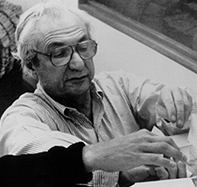
Frank Gehry is Design Principal for the firm of Frank O. Gehry and Associates, Inc., which he established in 1962. Before founding the firm, Gehry worked with architects Victor Gruen and Pereira & Luckman in Los Angeles, and with André Remondet in Paris.
Raised in Toronto, Frank Gehry moved with his family to Los Angeles in 1947. Gehry received his Bachelor of Architecture degree from the University of Southern California, and he studied city planning at the Harvard University Graduate School of Design. In the years since, Gehry has built an architectural career that has spanned four decades and produced public and private buildings in America, Europe, and Asia. In an article published in The New York Times in November 1989, noted architecture critic Paul Goldberger wrote that Gehry's "buildings are powerful essays in primal geometric form and . . . materials, and from an aesthetic standpoint they are among the most profound and brilliant works of architecture of our time." Hallmarks of Gehry's work include a particular concern that people exist comfortably within the spaces that he creates and an insistence that his buildings address the contexts and cultures of their sites.
Gehry's work has earned him several of the most significant awards in the architectural field. In 1977, he was named recipient of the Arnold W. Brunner Memorial Prize in Architecture from the Ameruopican Academy of Arts and Letters. In 1989, he was awarded the Pritzker Architecture Prize, perhaps the premiere accolade in the field, honoring "significant contributions to humanity and the built environment through the art of architecture." In 1992, he received the Wolf Prize in Art (Architecture) from the Wolf Foundation. That same year, he was named the recipient of the Praemium Imperiale Award by the Japan Art Association to "honor outstanding contributions to the development, popularization, and progress of the arts." In 1994, he became the first recipient of the Dorothy and Lillian Gish Award for lifetime contribution to the arts. In 1998, Gehry received the National Medal of Arts and became the first recipient of the Friedrich Kiesler Prize. In 1999, he received the Lotos Medal of Merit from the Lotos Club and the Gold Medal from the American Institute of Architects.
Gehry was named a Fellow of the American Academy of Arts and Letters in 1987, a trustee of the American Academy in Rome in 1989, and a Fellow of the American Academy of Arts and Sciences in 1991. In 1994, he was bestowed with the title of Academician by the National Academy of Design. In 1998, he was named an Honorary Academician by the Royal Academy of Arts. Gehry has received honorary doctoral degrees from Occidental College, Whittier College, the California College of Arts and Crafts, the Technical University of Nova Scotia, the Rhode Island School of Design, the California Institute of Arts, the Southern California Institute of Architecture, the Otis Art Institute at the Parsons School of Design, and the University of Toronto.
In 1982, 1985, and 1987-89, Gehry held the Charlotte Davenport Professorship in Architecture at Yale University. In 1984, he held the Eliot Noyes Chair at Harvard University. In 1996-97, he was a visiting scholar at the Federal Institute of Technology in Zurich, Switzerland. Gehry was elected to the College of Fellows of the American Institute of Architects (A.I.A.) in 1974, and his buildings have received over 100 national and regional A.I.A. awards.
Gehry's work has been featured in major architectural publications and in national and international trade journals, as well as in Newsweek, Time, Forbes, The Economist, Vanity Fair, Art in America, The Wall Street Journal, The New York Times, The Los Angeles Times, The Washington Post, Le Monde, L'Express, El Correo, and Frankfurter Allgemeine. Gehry's architectural drawings and models, as well as his designs for cardboard and bentwood furniture and his interpretations (in various forms and materials) of fish, have been exhibited in major museums throughout the world.